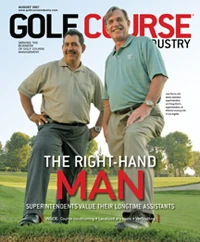Mowers may cut most of the turfgrass on a golf course, but it’s the little things handheld equipment maintains that helps keep a course looking pristine. Superintendents look for quality products from suppliers, and for Calvin Van Rees, when it comes to purchasing handheld equipment, he opts for products of which he’s familiar.
“I’ve worked with Stihl enough to know what I’m getting, and I like the quality,” he says.
When searching for tools, Rees, who is the superintendent at the 18-hole Westwood Golf Course in Newton, Iowa, looks for a small equipment dealership in town he can help. After researching equipment, Rees purchases the best product he can, so he went to one of the manufacturer’s dealers.
“We don’t want the biggest and the best, but we also don’t want the cheapest,” he says.
Rees, who has been at Westwood five and a half years and previously worked at Newton Country Club as assistant superintendent, wants equipment that can stand up to the rigors of the job. The tools are going to be tossed around and dropped, so he wants products that are durable and dependable.
“Stihl products separate a good job from a half-ass job,” he says.
Rees’ fleet of handheld equipment includes:
- Three FS 85 string trimmers (Stihl);
- One edger (Redmax);
- One blower (Redmax);
- Two Farm Boss MS 290 chain saws (Stihl); and
- One MS 280 chain saw (Stihl).
The Redmax blower and edger were bought previous to Rees’ arrival, but when it comes time to replace them, he plans to buy Stihl equipment.
“The blower isn’t ergonomically correct,” he says. “A person feels like their elbow is going to fall off after using it.”
Rees also knows that when he orders a replacement part the distributor will have it on hand or shipped to him in less than two days nine out of 10 times. Rees says he doesn’t know of a local Redmax distributor.
Rees’ annual maintenance budget is about $335,000, and of this budget, he spends no more than $1,500 for trimmers, edgers, blowers and chain saws. His annual maintenance budget is a combination of the operating and labor budgets. The labor budget includes the cost of insurance for workers and golfers (who can be injured on the course), as well as workman’s compensation.
Rees says he would never rent handheld equipment because it’s much easier for him to send broken equipment to the on-site mechanic rather than send it back to the company from which he rented it. He doesn’t see the cost effectiveness of renting handheld equipment and or the cost effectiveness of repairing broken-down equipment continuously.
“We use the tools until we need to purchase new ones,” he says. “And sometimes, when there’s extra money in the budget, I use it to buy new equipment before the money is used for something else.”
The handheld equipment lasts awhile because it’s not used daily. The oldest trimmer is 6 years old, the edger and blower are at least 10 years old, and the chain saws last an average of five years.
The Westwood crew use the trimmers and edger around bunkers, trees, ball washers, cart paths, water coolers and the clubhouse. The crew uses the blower on greens and tees and chain saws for tree removal and cutting weather-damaged branches.
The staff uses the edger twice a year, during the spring and fall – 25 hours a year at most. The crew uses the blower two and a half to four months out of the year on an average of 10 to 20 hours a week.
Even though the handheld equipment isn’t used every day, Rees and the crew still have to keep up on the maintenance. They clean equipment once a week, which includes scrapping off grass and checking engines and air filters.
Westwood’s full-time staff consists of six workers. During the season, (April 1 to Nov. 1) the staff fluctuates between nine and 13 workers.
Rees has been in the industry for 13 seasons and has been using Stihl products almost as long. He knows what kind of quality and service he’s going to get, so his purchasing philosophy is to stick with what he knows. GCI
Editor’s note: The inclusion or lack of inclusion of any manufacturer in this article doesn’t mean the magazine endorses or favors any one product, program or company.

Explore the August 2007 Issue
Check out more from this issue and find your next story to read.
Latest from Golf Course Industry
- Carolinas GCSA raises nearly $300,000 for research
- Advanced Turf Solutions’ Scott Lund expands role
- South Carolina’s Tidewater Golf Club completes renovation project
- SePRO to host webinar on plant growth regulators
- Turfco introduces riding applicator
- From the publisher’s pen: The golf guilt trip
- Bob Farren lands Carolinas GCSA highest honor
- Architect Brian Curley breaks ground on new First Tee venue






